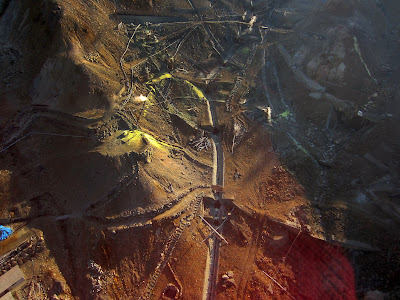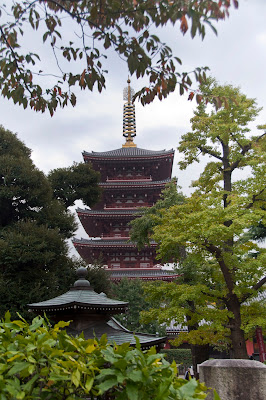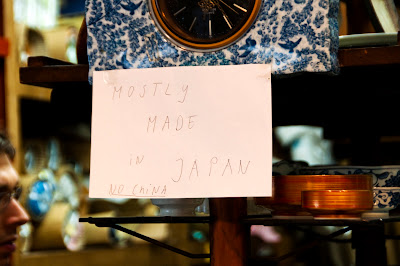For whatever reason,
I’ve never felt particularly compelled to visit Asia. I don’t know why, but it
just never called to me. At the same time I knew I would have to visit
eventually because I could hardly call myself a hearty world traveller if I
completely ignored the entire Far East. Besides, maybe I’d be pleasantly
surprised like I was by Berlin or Patagonia—places I visited by chance and with
which I absolutely fell in love.
So somehow I found
myself heading to Japan with my friend Karen in November (yes, I’ve been back
for 8 months). I think that last year—when I visited Istanbul and set foot on
the Asian continent for the first time—I felt like I was cheating to say I’d
now “been to Asia” and really had to go. And I knew it was a place that Karen
really wanted to visit. So thus therefore, we went.
So how was it?
Fascinating. I loved it. It was so completely different from any other place
I’ve ever been before—and from Estonia to Easter Island, I think I’ve been to
some pretty “out there” places. It isn’t the most overwhelmingly beautiful
country—most of the architecture has been destroyed by earthquakes and fires
and wars, and the natural beauty is nice, if not outstanding. But the culture
and the people are the highlight of the trip.
On the one hand, it is
so completely and truly foreign. Certainly the language is unfathomable for a
foreigner; but so is the myriad of customs. From the moment you land at Narita
and get on the train into Tokyo, you know: the conductor and the woman pushing
the snack cart stop to bow each and every time they enter or exit each and
every train car. Yep, you’re definitely not in Kansas anymore.

But on the other hand,
you're never lost or at a loss. The Japanese people may not be as outgoing as
the Aussies or as friendly as the Kiwis, but they will stop at nothing to make
sure that you, as a visitor to their country, are cared for. You can’t stand
somewhere and look confused for more than 2 seconds before some passer-by will
stop to offer help. At the massive and labyrinthine (whew) Shinjuku Station in
Tokyo, a young man offered assistance and ended up staying with us for nearly
half an hour, helping us pick up our rail passes and then making sure we found
and made our first train. And this is just one example of countless times we
encountered similar people—total strangers who were pleased and proud to take
any and every opportunity to ensure your visit to their native land was a
positive one. In fact, it's said that the only reason some people might appear
aloof or to avoid foreigners is because they don’t speak English and would be
embarrassed that they can’t help you.

Of course this extends
not just to strangers but also to your hosts. One night we took a taxi to a
restaurant. The taxi got to the block, but we didn’t initially see the
restaurant we were going to. We were happy to get out and find it because it
was no doubt only steps away. But our driver wouldn’t hear of it: he turned off
the meter, called information on his own cell phone to get the phone number of
the restaurant, called the restaurant to find out exactly where it was on the
block, and then pointed it out to us. And after all that, he refused a tip.
Japan is not a tipping country—their courtesy simply comes from pride.

I realize this is a lot
of text for what is normally a photo-based blog…but for me the real magic of
Japan is something that cannot be captured in photos. It is the people and the
culture and the spirit that make it special. I don’t even feel my words do it
justice; it is simply something that must be experienced to be understood. And
over two weeks, we experienced about half the main island of Honshu.
That said, I didn’t take
12,000 pictures for nothing so let’s get on with the show and our first
stop…Tokyo! Much like Athens, a lot of people tell you to fly in and then skip
it but how could you not visit Tokyo?! Sure, it’s mostly a modern metropolis
(most of it having been destroyed by various fires,
earthquakes, wars, and the occasional mutant dinosaur) but it has
some beautiful sites.
We stayed at the famed
Park Hyatt (where Lost in Translation was filmed) because you only live once,
and although not centrally located it otherwise lives up to the hype of beautiful
views and incomparable service. The first day we wandered to our first shrine,
Kumano, in Shinjuku Central Park.
It appeared to be some
kind of special holiday whereupon local families brought their children dressed
up in their finest traditional Japanese garb. They were, of course, adorable.
There was also a couple
having their wedding photos taken. The bride was simply stunning.
Also in Shinjuku Central
Park, we happened along some kind of festival of traditional Japanese challenges,
including sword fights and Yabusame, a type traditional Japanese archery where a
rider on a running horse shoots three special "turnip-headed" arrows
successively at three clay targets.
Here's a short video of
a guy missing the target, and then a guy hitting the target to cheers from the
crowd:
There was also this
random older gentleman with plastic hoppy insects on his hat. I don’t think he
was part of the show but he was equally entertaining.
As night fell, we
wandered over to the Imperial Palace, home to His Imperial Majesty Emperor
Akihito. It’s not open to the public but the grounds are, and this was the best
view we got.
Tokyo’s nightlife is
infamous, particularly the crazy shops and outfits of the “Shinjuku Girls”.
There’s a lot more to
Japanese cuisine than sushi and teriyaki, and that night we discovered the one
that would be come my favorite: okonomiyaki. It’s kinda like an omelet in that
it is egg-based with stuff in it, but the ingredients and styles vary by
region. Often you cook it yourself on a teppan. Here’s Karen all pumped to eat:
my okonomiyaki on the left is a more watery style called monjayaki or
"Tokyo style", while hers on the right is more solid like an omelet
(the more traditional kansei or "Osaka style").
The next morning the
weather was clear, giving us a rare and beautiful view of Mt Fuji from our
high-rise hotel. The absence of weather or pollution made this view a special
treat.
Karen found that a
regional dance festival was taking place in the somewhat far-flung neighborhood
of Daiba, so we went. It was a little trippy given how much the area looked
like New York, right down to a scale model of the Statue of Liberty!
We made it an early
night because the next morning it was off to the famed Tsukiji Fish Market.
Bright and early every morning fishermen bring in their fresh catches and sell
it to dealers from restaurants and the such. The prized tuna is auctioned off
(we didn’t make it to the auction) and then the rest is butchered and sold by
fishmongers in a giant warehouse that’s exhilarating (though not well-suited for
the squeamish).
For the average
visitors, the highlight is the opportunity to have a sushi brunch in one of the
teeny-tiny little sushi establishments in one area of the market. Each has
enough room for maybe 10 people at a time so you may have to wait on line for
hours to get in, but it’s your chance to have the best, freshest sushi in the
world—from fish that were literally swimming in the ocean only hours before.
Our sushi chef didn’t
speak a word of English but we loved him because he was very smily and his
eyebrows spoke volumes.
We headed up to the
neighborhood and shrine of Asakusa. This shrine was very grand.
You quickly learn that
the symbol for Shinto is a backwards swastika…but it definitely leads to a
little but of confusion for some.
That night it was ramen
time! The real deal is a little more involved (and a lot more delicious) than
the Marchuan packets that got us through college.
For our last evening,
we enjoyed drinks and live jazz at the Park Hyatt’s rooftop bar, again made
famous by Lost in Translation.
With the capital behind
us, we were off to discover the rest of Japan—well, at least as much as two
week would allow us. Our first stop was Hakone, BUT BEFORE WE GO…A FEW PARTING
SHOTS!
Gumby, Pokey, and their
new Japanese pal and tour guide Domo in my First Class seat on ANA. This was my
first-ever First Class experience (I was using miles and Business class was
full) and it is something. You have your own little “cabin” and of course the
Japanese service is outstanding. They make your bed for you and remake it if
you get up to pee. This was just days after Hurricane Sandy and before the
flight the purser came over to me to tell me how sorry she was about the
devastation my city had suffered. It was kind of embarrassing to have a
Japanese person say that to an American after all they've been through but it
was my first taste of uniquely Japanese humility and hospitality.
“How embarrassing…we’ve
shown up in the same outfit.”
The Japanese seem to
have some of the oddest fads. Right now this one is popular: fake animal tails.
The rivalry with China
(and Korea) is clear.
Karen and her new
boyfriend.
Yes, they do love their
Hello Kitty.
I don't remember what
we were shopping for here but apparently it comes in varieties for humans and
hippos.
This is perhaps the
world's worst amusement park ride.
Funny signs are a dime a
dozen, so here are a few of my favorites—especially the last one.
Next stop, HAKONE!














































































































